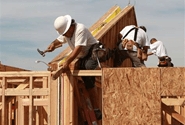Analysis

February 19, 2020
January Housing Permits Suggest Strong Start for 2020
Written by Sandy Williams
Housing starts slowed in January but remained at a solid pace, while building permits surged to a 13-year high.
January starts were down 3.6 percent from December to an adjusted annual rate of 1,567,000, but were 21.4 percent higher than a year ago.
Construction starts for single-family homes fell 5.9 percent compared to December. Multi-family residences of five units or more gained 3.0 percent.
“The housing recovery continues, as single-family housing starts have surpassed one million for the second consecutive month and multifamily production has been running above 500,000 for the same period,” said NAHB Chairman Dean Mon, a home builder and developer from Shrewsbury, N.J. “Meanwhile, builder confidence remains solid as demand continues to pick up.”
Construction in the Northeast was strongest, gaining 31.9 percent in January followed by a gain of 1.2 percent in the West. Winter weather stalled construction in the Midwest, falling 25.9 percent, and starts in the South were down 5.4 percent.
Permit authorizations, a predictor of future construction, were 19.2 percent higher than December and 18.9 percent above the January 2019 rate. Building permits were at a seasonally adjusted annual rate of 1,551,000. Authorizations for single-family homes grew 6.4 percent last month, while multi-unit permit authorizations increased 15.2 percent compared to December.
“While the solid pace for residential construction continues, favorable weather conditions may have accelerated production in the winter months,” said Nanayakkara-Skillington, NAHB’s Assistant Vice President of Forecasting and Analysis. “At the same time, the growth in permits is a harbinger that that market will continue to move forward in the coming months, even as builders grapple with supply-side issues like excessive regulations, labor shortages and rising material costs.”
Permit authorizations soared 34.6 percent in the Northeast, followed by gains of 8.2 percent in the Midwest, 8.0 percent in the South and 3.1 percent in the West.







